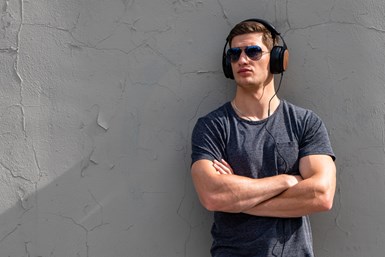First Headphones to Market Made of Sustainable Materials
thinksound’s new over-ear headphones made with Eastman’s Tr膿va Engineering Bioplastic
What is said to be the first over-ear headphones produced with sustainable materials have been commercially launched by thinksound, known for its high-end, responsibly produced audio equipment. The new ov21 headphones are molded with Eastman’s cellulose-based engineering bioplastic Tr膿va which contains more than 40% biobased content derived from sustainably harvested trees.
Based in Burlington, Ont. (Canada), thinksound was formed in 2009 by engineer Aaron Fournier, who dedicated himself to creating audio products that truly respect the art and craft of music professionals. The company has received critical acclaim from top industry publications. Stereophile, considered the “bible” for audio enthusiasts, handed thinksound the Recommended Component Award nine years in a row and Digital Trends, a premier source of news & lifestyle media, has awarded thinksound the Editor's Choice numerous times.

What are said to be the first headphones to market made of sustainable materials use Eastman’s Treva.
Fournier says his company has always had sustainability as part of our mission, Previously, it molded headphones from post-consumer recycled material or regrind. “This created a challenge with new product development because we had to minimize the use of plastic,” Fournier says. “Tr膿va offered us an opportunity to develop headphones in an environmentally responsible way while meeting our rigorous standards for acoustic performance."
Tr膿va is a USDA-Certified Biobased polymer that has been shown to offer excellent acoustic properties in addition to the durability, chemical resistance and processability required for engineered applications in consumer electronic devices.
“We looked at a variety of different materials and plastics common in headphone manufacturing, but nothing really came close. As soon as we saw what Eastman was doing with Tr膿va, we jumped at the opportunity to make it work for our products. Almost everything we considered before Tr膿va had to be rejected because we either had to compromise on the environmental impact or on the quality of the sound. We weren’t willing to do either.”
Fournier adds, “We opted for Treva because we could get the material easily and it would pass our acoustic and durability test—this this was the real selling point. This material offered thinksound an opportunity to develop new headphone designs in an environmentally responsible way while meeting its standards for acoustic performance. The company now has the flexibility to create almost any audio product its customers desire.”
The headphones are molded in China by a company thinksound has been working with for more than 16 years. According to the injection molder, whom thinksound did not identify, the process has been seamless and straightforward. There has been no lag in manufacturing time or difficulty using Tr膿va in thinksound's products.
thinksound already has two new wireless headphone products at the prototype stage that will be using Tr膿va, and possibly Tritan as well. The proprietary amorphous copolyester Tritan is also available in the Tritan Renew version with 50% certified recycled content.
Related Content
-
Prices of All Five Commodity Plastics On the Way Up
Despite earlier anticipated rollover in prices for most of the volume commodity resins, prices were generally on the way up for all going into the third month of first quarter.
-
Prices for PE, PS, PVC, PET Trending Flat; PP to Drop
Despite price increase nominations going into second quarter, it appeared there was potential for generally flat pricing with the exception of a major downward correction for PP.
-
Polymer Showdown — PC/ABS vs. PC/PBT — May the Best Material Win
First in a series, experts from plastics engineering consultancy The Madison Group will pit leading thermoplastics against each other to see how they differ in processing characteristics, chemical resistance, thermal and mechanical performance, and more.






